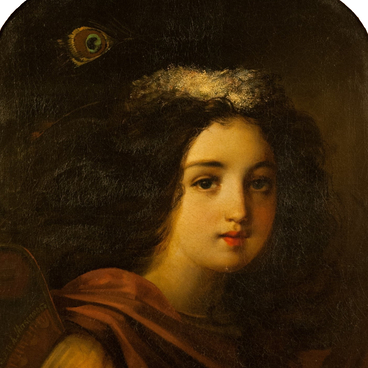The table candlestick is made of bronze. Its candle cup is supported by a rocaille-shaped stem (rocaille is an exuberant decoration of curves and undulations modeled after a seashell). Its round base is decorated with a relief pattern.
Candlesticks were preferably made of fireproof metals such as brass or bronze, however, occasionally, wood, ivory, glass or porcelain could be used. The shape of a candlestick was ever changing, following the latest interior decoration trends. As the new styles appeared and developed, so did the details of a candlestick.
Bronze or brass candlesticks had become part of everyday life since around the fifteenth century. A candlestick or a candelabrum (candlestick with multiple arms) were an essential part of a writing desk as well as holiday decoration, especially since the late eighteenth century. Most candlesticks consisted of a large base and a pricket (sharp point onto which a candle is placed) to which a candle cup and a bobèche (wax pan to catch melted wax) were attached.
This candlestick, too, includes a candle cup decorated with a simple geometric pattern. Its bobèche is made of a lighter-colored metal. Curiously, the Russian term “bobeshka”, although derived from French, means a candle cup rather than a wax pan, and “profitka” is used to describe a bobèche.
This candlestick was made after a sketch by Maximilian Messmacher (1842-1906), a German-born Russian academician architect, professor of the Imperial Academy of Fine Arts, author of numerous buildings in Moscow and Saint Petersburg, and creator of Massandra palace which was completed in 1902. The candlestick was cast in a bronze workshop of Baron von Stieglitz’s Central School of Technical Drawing in Saint Petersburg (Messmacher was its director for almost twenty years from 1879 to 1896). The candlestick had been kept by Messmacher’s family for generations until the architect’s great-grandson Oleg Kondiain gifted it to the museum.
Candlesticks were preferably made of fireproof metals such as brass or bronze, however, occasionally, wood, ivory, glass or porcelain could be used. The shape of a candlestick was ever changing, following the latest interior decoration trends. As the new styles appeared and developed, so did the details of a candlestick.
Bronze or brass candlesticks had become part of everyday life since around the fifteenth century. A candlestick or a candelabrum (candlestick with multiple arms) were an essential part of a writing desk as well as holiday decoration, especially since the late eighteenth century. Most candlesticks consisted of a large base and a pricket (sharp point onto which a candle is placed) to which a candle cup and a bobèche (wax pan to catch melted wax) were attached.
This candlestick, too, includes a candle cup decorated with a simple geometric pattern. Its bobèche is made of a lighter-colored metal. Curiously, the Russian term “bobeshka”, although derived from French, means a candle cup rather than a wax pan, and “profitka” is used to describe a bobèche.
This candlestick was made after a sketch by Maximilian Messmacher (1842-1906), a German-born Russian academician architect, professor of the Imperial Academy of Fine Arts, author of numerous buildings in Moscow and Saint Petersburg, and creator of Massandra palace which was completed in 1902. The candlestick was cast in a bronze workshop of Baron von Stieglitz’s Central School of Technical Drawing in Saint Petersburg (Messmacher was its director for almost twenty years from 1879 to 1896). The candlestick had been kept by Messmacher’s family for generations until the architect’s great-grandson Oleg Kondiain gifted it to the museum.



